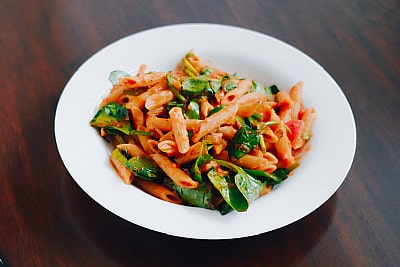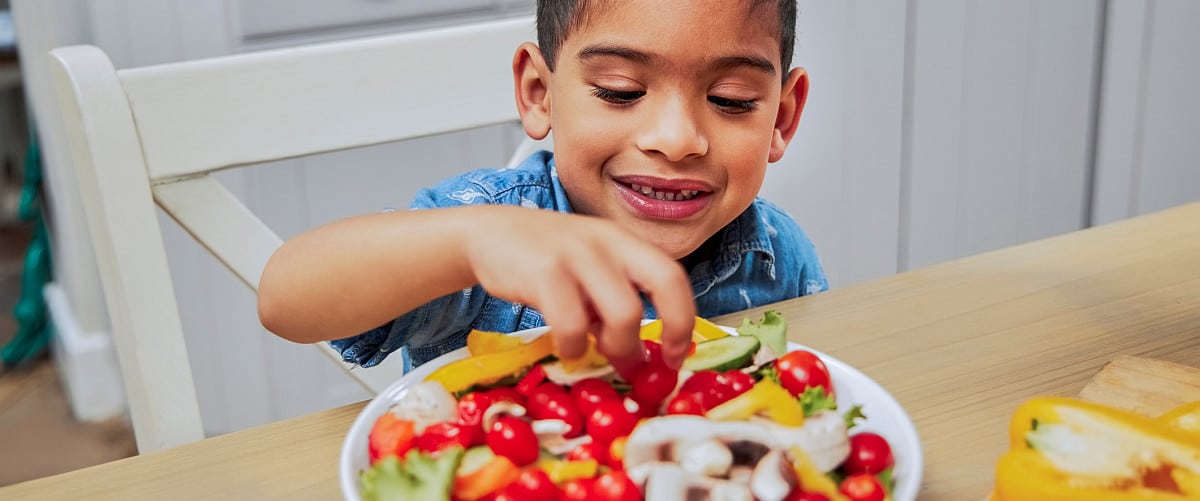If you have kids, you might be engaging in nightly negotiations over broccoli and Brussels sprouts. They may refuse to eat the perfectly prepared green beans you serve. Or they try a cucumber, spit it out, and swear one will never touch their lips again.
Getting kids to eat their vegetables is an age-old dilemma—and often a source of stress. We know vegetables are important. The nutrients they provide help children grow and stay healthy, promote a healthy weight, and ultimately help prevent chronic disease.
But still only around 10% of kids are getting the recommended amounts of vegetables in their diet at a time in their life when establishing healthy eating and food preferences is key.
What’s a Parent to Do?

As a parent, you probably have tons of questions about your child’s nutritional health. Are they getting what they need to fuel their bodies and minds? What’s the best way to engage them to encourage healthy habits like eating enough veggies?
In this installment of our “What’s a Parent to Do?” blog series, we tackle kids and veggies. With help from Anne Pantoja (pictured), Aramark Student Nutrition food service director who’s also a chef and registered dietitian, we’ve identified top takeaways, tips, and guidance when it comes to kids and vegetables.
“Kids often think vegetables are boring and yucky, so it’s all about trying to make the vegetables interesting, and finding the ones your kids like,” says Anne. “It’s showing them different preparations, eating vegetables yourself, and having a ‘flavor first’ mentality.”
Q: Why are veggies so important for kids anyway?
 Vegetables contain essential vitamins, minerals, fiber, and other micronutrients that young bodies need to grow and develop. Some of these nutrients can also help strengthen their immune systems.
Vegetables contain essential vitamins, minerals, fiber, and other micronutrients that young bodies need to grow and develop. Some of these nutrients can also help strengthen their immune systems.
Exposing kids to veggies from a young age can help ensure they become lifelong vegetable eaters. The USDA recommends kids and teens consume anywhere from 1 to 4 cups of veggies every day, depending on their age.
Pantoja has found that younger kids tend to prefer simpler preparations, for example, baked cauliflower with salt and butter. “Once kids reach middle school, though, they really start to enjoy different mixtures and blends,” she says.
Q: Why do so many kids seem to hate vegetables?
Disliking the taste of veggies at first is completely normal for kids. Babies get used to the sweet flavors of formula and breast milk so the comparatively bitter, earthy, and tangy taste of vegetables can be jarring once they start eating food.
Getting used to, and growing to enjoy, vegetables is a process that won’t happen overnight. Kids’ taste buds continue to grow and evolve. That’s why what might be a hated vegetable today is tolerated, or even loved, a year from now. What’s important is to introduce veggies early on.
Q: Is sneaking veggies into my kid’s food a good strategy?

Recipe: Black Bean Brownies
Experts disagree on this. One study showed preschool kids with veggies hidden in their meals ate almost twice as many veggies during the day. The children also consumed around 11% fewer calories this way.
At the same time, hiding vegetables in purees, smoothies, or pasta sauces mutes flavors and doesn’t give kids the opportunity to learn to enjoy vegetables’ many tastes and textures.
In general, a little sneaking is okay, as long as you balance it with other strategies, according to Anne.
“I believe in eating food in its purest form,” Anne says. “Sometimes when you sneak food in, kids will say the food doesn’t taste right. But I have a great recipe for black bean brownies made with applesauce, beans, dark chocolate, and honey and kids absolutely love it—even more so because they know about the creative ingredients I put in them.”
Q: What happens if my child just won’t eat any veggies?
 If your child won’t eat any veggies, don’t panic. Just get more creative in the kitchen.
If your child won’t eat any veggies, don’t panic. Just get more creative in the kitchen.
“There are so many different vegetables out there,” says Anne. “Start by getting the freshest, highest quality veggies you can. Then experiment. Put a little cheese on broccoli, roast carrots if your child thinks they’re too mushy steamed. It’s all about the preparation and presentation. You have to put the love and care into it for vegetables to be more accepted. You have to think outside the box.”
At the same time, many of the essential vitamins and minerals in veggies are found in other foods, like fruit, beans, and whole grains.
So, while you want to keep introducing and reintroducing vegetables, your child can still get health benefits if they’re eating a balanced diet that’s low in processed foods and full of other nutrient dense whole foods.
Check with your pediatrician to make sure they’re keeping up with their growth charts. If their doctor is happy with how they’re growing, don’t stress over veggies. Know that taste buds will evolve and keep introducing and reintroducing veggies during meals.
Q: Are there specific veggies I should encourage my kids to eat?

Recipe: Spinach Pasta Toss
While eating a wide variety of veggies in all colors (orange carrots, purple eggplant, and white cauliflower, for example) is important, green, leafy veggies should be a staple whenever possible.
“It’s important for kids to at least try dark, leafy greens. They are packed with nutrients,” Anne says. One method she’s found success with is sautéing spinach and adding a bit to mashed potatoes. “It gives it a little different flavor and some color,” she says.
Restaurants can be good places to experiment with different foods. “When ordering, try to step outside the box,” encourages Anne. “Don’t just get that order of fries. Maybe the restaurant makes a vegetable in a different way than you do at home and your child will say, ‘Wow, that’s really good!’”
Q: What about the “eat your broccoli, then you can have dessert” technique?
 This is still a popular tactic for some families, but it’s not a great approach. When you do this, you make the vegetable something to get through so your child can enjoy what they then see as a “good food.” You don’t want to create this type of negative association with veggies.
This is still a popular tactic for some families, but it’s not a great approach. When you do this, you make the vegetable something to get through so your child can enjoy what they then see as a “good food.” You don’t want to create this type of negative association with veggies.
Instead, it’s better to create a no-pressure environment where trying vegetables isn’t necessarily tied to rewards. If your child is rewards-driven, it’s okay to use something other than food to commemorate the moment of trying something new, like a sticker.
Another good strategy is a “thank you bite.” Ask your child to take a small bite of a veggie as a way of thanking whoever prepared the dish.
Q: Do I need to replace vegetables with vitamins?
Supplements can’t perfectly mimic the variety of nutrients in veggies, so real food is always the best bet.
Some kids, however, may have vitamin or mineral deficiencies that can’t fully be addressed with foods. Talk to your child’s doctor if you’re concerned or wonder if you should add a multi-vitamin to their regimen.
12 Tips to Get Kids to Eat Their Veggies
Registered dietitian Anne recommends trying some of these tips to encourage your child to eat more veggies.
Use different textures and preparations. Some kids prefer certain textures over others. For example, one child might like purees and another roasted veggies. Try vegetables raw, steamed, in a stir-fry, pureed, in soups, incorporated into baked goods, or even frozen. For some kids, frozen peas can make a tasty snack. Anne says kale chips—oven baked, with salt—are hit with her kids.
 Serve veggies as an appetizer. Before dinner is served, lay out a communal plate of raw veggies like carrots, bell pepper strips, green beans, sugar snap peas, and cherry tomatoes as an appetizer. Some parents, knowing their kids are really hungry right after school, even bring a container of raw veggies in the car to school pick-up.
Serve veggies as an appetizer. Before dinner is served, lay out a communal plate of raw veggies like carrots, bell pepper strips, green beans, sugar snap peas, and cherry tomatoes as an appetizer. Some parents, knowing their kids are really hungry right after school, even bring a container of raw veggies in the car to school pick-up.
Offer sauces and spice options. Let your kids dip their veggies in sauces they like to get them interested, such as yogurt, light ranch, or even hot sauce with a touch of honey if they like spicy things. Experiment with seasoning vegetables with different oils and spices like olive oil, a dash of salt and pepper, or a sprinkle of thyme, oregano, or cumin. Some parents give their kids the job of making a dressing for their nightly salad.
Layer flavors. Anne plays around with layering different flavors. For example, when making broccoli for her own kids, first she prepared it with a little salt and pepper. The next time, she added some olive oil, too. Then, she made broccoli with salt, pepper, olive oil, and lemon. “You never know who’s going to like what,” she says.
Grow your own veggies. Involving kids in growing their own vegetables—from planting seeds to watering their plants to then harvesting the veggies—can excite kids and inspire them to try and enjoy the fruits of their labor, Anne says.
Let kids choose their own veggies. When buying vegetables, whether it’s at the grocery store or a local farmers’ market, let your kids pick the produce themselves, Anne recommends. Interacting with the farmers who grew the food adds another layer to the outing. “Having your kids help you prepare the vegetables can get them excited about eating them, too,” she says.
Try flavor conditioning. This technique involves pairing a new food with a flavor your child already knows and likes. For example, roast carrots with honey or pair broccoli with tomato sauce. Also, offer new veggies alongside ones they already like.
 Encourage games and fun. Give fun names to vegetables like X-ray vision carrots. Build funny faces or monsters out of veggies. For young kids, some parents have found outings to their local zoo to see animals eat their veggies has encouraged their kids to ramp up their vegetable eating. Read: 6 Ways to Make Healthy Food Fun for Kids.
Encourage games and fun. Give fun names to vegetables like X-ray vision carrots. Build funny faces or monsters out of veggies. For young kids, some parents have found outings to their local zoo to see animals eat their veggies has encouraged their kids to ramp up their vegetable eating. Read: 6 Ways to Make Healthy Food Fun for Kids.
Experiment with a variety of recipes. Tried-and-true recipes and techniques for some parents include:
- Dice veggies super small and put them in pasta sauces, purées, and chilis.
- Cook other vegetables into mashed potatoes, including carrots, sweet potatoes, cauliflower, and parsnips.
- Make veggie burgers with cheese and other toppings.
- Grate vegetables into baked goods like muffins, cakes, and breads.
- Cut up veggies for pizza toppings. Get the recipe: Grilled Veggie Pizza.
- Add veggies to fruit smoothies. Try: 1 banana, half a bag of baby spinach, and a little orange juice.
- Mix frozen carrots and peas into macaroni and cheese.
- Add extra peas and carrots to chicken pot pies.
- Make fried rice with half white or brown rice and half cauliflower rice, lots of peas and carrots, and any other veggies you have on hand (e.g., bell peppers and zucchini).
- Put shaved carrots, zucchini, or spinach in oatmeal. Get the recipe: Savory Breakfast Bowl.
Offer interactive veggies. Steamed artichokes can be fun for kids to rip off the leaves and then dip them into a little melted butter. Fava beans are another one to try—peel the pod, open the bean, take the skins off, then eat them.
Walk the walk. Kids are sponges, so modeling behaviors you want them to adopt can work. Show them veggies are great by eating them yourself or try a food you’re wary of.
Don’t get defeated. Know that it often takes ten or more tries with a new food before a child starts to actually open up to it, so be persistent and it will often pay off. “You don’t want to force it,” says Anne. “But, also, don’t give up!”
Anne Pantoja is a Registered Dietitian and part of Aramark’s Nutrition Network—a community of dietitians within Aramark Student Nutrition. The Nutrition Network connects and engages Aramark Student Nutrition RDNs and other nutrition experts in ways that benefit school students, parents and caregivers, and their district’s health and wellbeing initiatives.
Note: Since everyone’s health history and nutritional needs are so different, please make sure that you talk with your doctor and a registered dietitian to get advice about the diet and exercise plan that‘s right for you.

